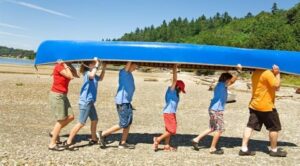An unwise acquisition almost sank a Nashville printing company founded in 1919 by the Francis and Lussky families.
By Howard Muson in Family Business Magazine
Larry Lussky: You’re handed the helm of the Titanic right before you’re going to hit the iceberg.
Richard Francis: You’re not handed the helm. You have to pry off the fingers of the guy steering the ship, who doesn’t see what’s up ahead.
Larry Lussky: You know that unless you do something real quick, you’re going to hit the iceberg, you’re going to blow up.
Richard Francis, 42, and Larry Lussky, 45, are both good salesmen who enjoy telling a story. When relating the hair-raising events of the past two years, the two partners do it with a certain drama and flair, but also a deep sense of relief, each embellishing on the other’s points and giving generous credit to the other for saving the ship.
The Francis and Lussky families of Nashville, Tennessee, have been working together since 1919, in a printing business founded by Richard’s grandfather and Larry’s great– grandfather. Throughout almost all of its history, the conservative Nashville company had made a profit supplying decorative holiday calendars and other promotional items such as mugs and pens to businesses.
F-L Companies was a model of how a partnership can be harmoniously maintained and passed down through generations. But when Richard and Larry took charge of F-L Companies in March 1992, it was not the result of a well-laid succession plan. Richard and Larry led a mutiny that resulted in the ouster of the third-generation president, Virgil (Bud) Francis III—Richard’s cousin.
The iceberg that loomed before the company and justified the abrupt—and painful—leadership change was bankruptcy. An unwise acquisition was bleeding a venerable company to death, threatening to destroy the equity of the families and the livelihoods of more than 100 employees.
F-L Companies has just emerged from a Chapter 11 restructuring, led by Richard, now president, and Larry, chairman. Their story dramatizes the risks to a family business of trying to grow too fast by buying a subsidiary in a new and complex market before it has the controls in place and the knowledge to manage it. The story also shows, however, that bankruptcy, though it is a fearful journey, can powerfully transform a company—if it manages to survive.
Sports Products of America (SPA) was a failing company when the Francis’s and Lusskys acquired it in 1984 by assuming its debt. The long-time second-generation leader of F-L Companies, Virgil Francis II, had died only the year before. The new management team led by president Virgil (Bud) Francis III and Chairman Monnie Lussky, Larry’s father, had been looking for an acquisition as a means of offsetting the seasonal revenues endemic to its core holiday calendar business. Based in Harriman, Tennessee, three hours away, SPA was in the business of printing logos on sportswear such as T-shirts and sweatshirts for college bookstores.
The acquisition made sense at the time, and everyone supported it, including Richard and Larry, then executive vice presidents. Imprinted sportswear was considered the wave of the future in the ad specialty products business. According to Bud Francis calendars were No. 1 in industry wide market share about 20 years ago, but had fallen to No. 5 or 6, while imprinted wearables had risen to No. 1. F-L already had a small business that printed logos on baseball caps, so the techniques involved were not unfamiliar.
If the acquisition seemed logical, it was also apparently driven by other motives. Larry Lussky says there was “a genuine desire on the part of top management to position our company as one of the top 100 companies in Tennessee in sales.” Larry describes what he calls the Messiah Complex. “We had been profitable since 1919. We were the white knights taking over this failing company. We said, ‘We’ll show you how to do it.’ Forget the fact that we didn’t know what we were doing—we had never sold sportswear.”
Bud Francis says the company needed to expand, in part, to make room at the top for family members like Richard and Larry who “were not making enough money for what they were worth.” The 56-year-old former president also suggests there were other family members who were not willing to retire or were in jobs for which they were not particularly well suited. Richard, however, points out that at the time there were only a total of six family members working in the company, and all were pulling their weight.
Larry’s dad was alone responsible for $1 million in sales, Richard says.
Whatever the reasons for wanting to expand, SPA in its first few years justified everyone’s hopes. The subsidiary, which had $1.2 million in sales when F-L took it over, was soon supplying sportswear to Wal-Mart stores. When it landed a $6 million contract with Kmart in 1987, there was celebrating at Nashville headquarters. “We had never seen a $6 million contract in our lives,” Larry recalls. “The combined companies had sales of $20 million in 1989, which put us in the top 100 companies in the city of Nashville. There was an article in the newspaper, and we were all patting each other on the back. You would have thought we’d all just had new babies.”
Supplying sportswear to large retailers, however, turned out to be as different from selling holiday calendars to businesses as soccer is from football as played in the NFL. While servicing large retailers such as Kmart, SPA was neglecting its core customers; college bookstores canceled orders because of late deliveries. The plant got into exotic youth and toddler fashions like slider shorts, youth shimmels, and parachute pants. To service the big retailers, F-L Companies had to invest in new automated screen-printing machines.
Meanwhile, as Larry and Richard tell it, the Harriman plant was over–ordering. As fashions changed, huge inventories piled up in the warehouse there. Instead of helping to offset the parent company’s seasonal revenues, SPA was causing F-L to take on more debt to buy new equipment. Eventually, it even had to mortgage its office building in Nashville to raise needed cash.
The family company had hired the former owner of SPA to run the Harriman plant and had given him a free hand. In retrospect, F-L managers agree that not having a family member—a Francis or a Lussky—present in Harriman supervising operations was one of the company’s biggest mistakes. Management in Nashville was not well informed about the deteriorating situation at the plant. Bud’s brother, Steve Francis, 54, an executive strong on the production side, went to live in Harriman and work with the former owner in 1989. But by then the operation was already heading south like a fast freight train.
To make matters worse, by 1989 Kmart had started to play tough with the supplier. According to Richard, it forced SPA to lower its prices and even “asked for a little help” with advertising. Kmart said, in effect, according to Larry, “This is the price at which we want you to sell us your garments, and it’s okay if you don’t want to do it. We have 20 other suppliers lined up who say they can do it for that amount of money.”
With SPA’s profit margins squeezed and debt rising at an alarming rate, an audit initiated that same year by Richard and Larry revealed that the more the subsidiary’s sales increased, the more money it was losing. The audit, done by an outside accounting firm, found that the company was losing roughly $1 for every shirt it sold. “I think you’re a good candidate for Chapter 11,” Richard and Larry were told.
When the two vice presidents laid the numbers out for the board—and mentioned “the B- word”—Richard says the first reaction was denial. The words came back in Richard’s face: “Don’t you ever mention that word around here again.” Larry says top management’s solution was: “‘We’ll sell our way out of it. Your job is to get out there and sell.’” That was fine, Larry adds, “but for every garment we sold we were losing a dollar.”
As losses began to mount, F-L put SPA on the block. Efforts to find a buyer during 1991 were unavailing, however, and pressure grew on Bud Francis to shut down the operation. When First American Bank declared F-L’s loan a problem asset, the issue reached crisis proportions. In November 1991, the F-L board voted to close the Harriman plant and informed the loan officer at First American of its intention.
Three months later, according to Richard and Larry, SPA was still operating with the same number of employees. During these months, Bud Francis was laying groundwork to convert SPA into a contract printer, which would put inventory in customers’ hands instead of F-L’s. He had lined up a group of investors to provide new capital for the venture. “I guess I was a little hard-headed,” the former president says in retrospect. “But I’m an entrepreneur-type, and I didn’t want to just walk away from it. Somebody once said an entrepreneur thinks that, given enough time, he can fix anything. I felt that I could do that.”
Bud’s plan, however, would have required a buyout of some of the Lusskys’ share of the business. Instead of a 50-50 stock split between the two families, Bud and the new investors would each control one-third of the shares in F-L Companies and the Lusskys, one-third. The Lusskys weren’t about to agree to that, Richard says.
Finally, in March 1992, with First American expressing deep concern about delays and lack of action on SPA, Richard and Larry made a formal presentation to the board. They argued that F-L Companies had lost its focus. Losses due to SPA had reached $7,000 a day. The company needed new leadership to stop the bleeding and return to the core calendar business, which was still showing a profit. The two had brought along a Cleveland consultant who supported their case. After an emotional debate that lasted 12 hours, Bud Francis was removed as president by a 5-to-1 vote, with Bud the lone dissenter. Larry, his brother, Edward, and their father lined up in the majority along with Richard and Steve Francis. Richard and Larry were put in charge of the company.
F-L was, however, running out of options. One week after assuming their roles, the new leaders were told by their loan officer at First American, “Richard, Larry, right now your company has zero credibility with us.” F-L faced the distinct possibility of liquidation.
The company’s credit line was subject to 30-day forbearance agreements, which meant it could be denied in any month. This uncertainty made it impossible to do business, Richard says. F-L was left with no choice but Chapter 11.
After announcing the phase out of SPA to employees in Harriman, Richard spent time overseeing operations in its final months. “I can’t tell you the depths you sink to,” he recalls. “Looking around this enormous warehouse, with racks of sportswear up to the ceiling, I couldn’t help thinking: ‘This is our company. This is what we have done with our equity, which took 75 years to build up. And Kmart is ready to put a bullet in our head if we are one minute late in shipping.’”
Larry admits the company’s mistake was a textbook classic. “You’re told about it in school, you read about it. But when you’re in the middle of it, you can’t see it. When I buy paper for our calendars, it’s white. It doesn’t matter if it sits in our warehouse for two months or six months. We can still use it. When I buy a half-million dollars-worth of ash- gray T-shirts, six months later ash gray isn’t the ‘in color’ anymore—it’s charcoal gray. What do you do with all those T-shirts?”
Once a company enters Chapter 11, it is navigating in uncharted seas. To stay afloat and complete the journey—only a fraction of firms make it—requires help from those who have been through it before. Richard and Larry worked with their auditor, two consultants, and their general counsel through some of the most stressful months of their lives, requiring helmsmanship—and salesmanship—of the highest order. “The first 90 days are crucial,” says Richard. “If you delay in taking action in those 90 days, you will probably do irreparable damage to your chances of success.”
The company’s 100-odd employees were demoralized and fearful of losing their jobs. The board fights polarized family members for the first time in the company’s history. One branch of the Francis family wasn’t talking to Richard. Another cousin, with whom he was close, resigned after the Chapter 11 filing. (“That was painful,” Richard says. “He left a note on my desk saying, ‘I’m out of here.’”) Bud’s brother, Steve, who had warned of the impending crisis along with Richard and Larry, remained loyal, staying on as manager of pre-press production. Larry’s brother, Edward, an electrical engineer, left late last year because the only job for him in the new company was in sales, for which he did not feel suited.
To come up with a reorganization plan that would satisfy creditors required endless meetings with the company’s advisors. The plant in Harriman, meanwhile, had to be shut down gradually, reducing employees but keeping enough of them to fill pending orders and work off some of the plant’s vast inventory. The core calendar business, which had remained steady throughout the crisis, needed to continue bringing in cash. Customers had to be reassured that their orders would be filled, and suppliers persuaded to accept stretched-out payment terms.
Meanwhile, the sharks were circling. Richard recalls: “Our competitors were telling customers, ‘Don’t buy calendars from them—they’ll never deliver. They’re going to be Chapter 7 in September.’ We had competitors calling up our top employees and going to their houses at night, offering them much more money than they were making with us.
Every day you walked in here, there was a gun pointed at your head. How do you make it? Hah, one word—fear. You’re driven by fear.”
Along with fear, Chapter 11 also brings clarity about who’s with you and who’s against you, who your real friends are in business and who cannot be counted on. Fortunately, F- L could count on old friends, people who had been doing business with their families for years. Large customers such as State Farm Insurance, Prudential, and Southern Farm Bureau Insurance were fully briefed by Larry. Most customers, Larry found, wanted to know only one thing: “Are you going to make me look bad? Or are you going to ship calendars the way you always have? If you don’t do it this year, there’ll never be another chance.”
Suppliers were willing to take a chance on F-L Companies, too. Most paper companies normally give 15-day or 30-day terms for payment. When Richard looked F-L’s largest paper supplier in the eye and asked for one-year terms, the man turned red. “Amazingly enough,” Larry says, “he gave us the terms and the paper we needed to keep going. I’ll never buy paper from anyone else. Never.”
With 120 days to come up with a restructuring plan, management had to get a clearer grip on its finances. Payment of debts depended on generating cash, cash, cash. “The way the books were set up,” says CFO Andy Jordan, hired just before the leadership change, “it was difficult to get a good picture except annually.” Costs had to be pared to the bone, and that meant austerity. The company announced a wage freeze, and Richard and Larry themselves took a salary cut. With the aid of a consultant, the company did a complete analysis of flow-through at the Nashville plant and discovered numerous repetitive steps in the handling of orders. A new plan was drawn up that cut out 75 percent of the steps, improving the plant’s speed and efficiency in processing orders.
To keep going, F-L needed support not only from customers and suppliers but from its own employees and managers. The new leadership saw that to mobilize the energies of employees, they needed to earn their trust. That required breaking down a “wall” that existed between the front office and the shop floor where the printing and binding of calendars was done. As Richard and Larry tell it, there was a widespread feeling among employees that managers were a special, privileged class. One way they began to chip away at the wall was by going to work on the shop floor themselves once a month, doing the ordinary tasks of printing and bindery employees. That began to change their image; it brought them closer to their employees, and generated trust.
Most important, they also went out on the factory floor to conduct briefings on their intentions and progress on the restructuring plan. “Fear of the unknown was terrible,” Richard remembers. “We tried to make everyone feel we were all in this together. Every two or three months we’d go out there with big flip charts: ‘Here are sales, here’s how much inventory we have, here’s how much we’ve sold, here’s how much equipment we have left at SPA…’”
When businesses are in financial straits, there is a tendency to close ranks, to withhold information, Richard and Larry believe. That’s a mistake, in their view. “Overloading your people with information is absolutely key,” advises Richard. “Hold virtually nothing back.”
Survival in Chapter 11 also made a team effort absolutely essential in the top ranks of management. The company’s executive committee was pared from a dozen or so managers to six. The soapbox speeches of the past were discouraged, so attention could be totally concentrated on solving real problems that posed potentially disastrous consequences. “We checked our egos at the door,” says Richard. “No one had all the right answers. Together we would find the right answers.”
Steve Francis attests to the transformation taking place at F-L Companies: “We were sharing information, bouncing ideas off each other. Here we were on the brink of disaster, but there was euphoria because we were able to openly discuss this stuff and not have to worry about getting into a shouting match.”
The restructuring plan approved last November provided for 100 percent repayment to secured creditors and between 30 and 38 cents on the dollar to unsecured creditors over a period of five years. A total of 75 percent of cash flow will be devoted to these payouts during the five-year period. Having emerged from Chapter 11 in just eight months, F-L received a new $2 million line of credit and $2.5 million in long-term loans from First American Bank.
F-L Companies has gotten its debt down from $7.5 million to $2.5 million. The first payment under the restructuring plan was made in July. The company even made a small profit in its last fiscal year. The 75-year-old family company has been through the tunnel and come out the other end a stronger organization, having returned to its core business.
People in F-L are thrilled that so many of their old friends stood by them in the crisis. “It was very heartening to see the support we got from suppliers,” CFO Andy Jordan says. Jordan attributes much of the support the company received to the business values of the owning families—particularly “Monnie Lussky’s ethic.”
“There were so many critical links in this chain,” adds Richard. “If any of them had broken, we were gone. If our largest paper supplier, Dennis Paper Co., did not give us the terms we needed, we were gone, because we had only so much money to run this company. Probably the easiest thing the bank could have done at the time was liquidate us. Zach Martin [special assets officer of First American] could have pulled the plug, but he didn’t. And I think he’s happy that he didn’t. We’ll be a good customer for that bank for as long as they want us.”co
Looking back on the crisis, Monnie Lussky, now 72 and chairman emeritus, recalls being so upset that he cried. “What upset me about the situation at the time was it seemed the harmonious relationship between the Francis family and the Lussky family, which had lasted so many years, no longer existed. I’m an emotional person, and it affected me deeply—and still does.”
The partnership, still 50-50 between the families, has now been re-cemented in a fourth generation, thanks to Richard and Larry. Monnie Lussky’s faith has been restored.
The reorganization of F-L Companies was probably one of the biggest challenges Richard and Larry will ever face in their business careers, requiring high-wire feats of daring, persuasion, and management skill. There’s no guarantee of smooth sailing ahead for a company that has been through two years of rough seas. But right now a mood of elation and pride pervades the Nashville company.
“No one can take away from us the feeling of having made it,” says Richard. “There are no guns pointed at our heads right now. We’ve got 100 people out there who are happy, who have good jobs. That means more than money to me.”
Howard Muson is a writer, editor and consultant, and former editor and co-publisher of Family Business Magazine.
Source: Family Business Magazine, Summer 1994
Copyright © 1994. Family Business magazine. Subject to the provisions of the Terms and Conditions of the Family Business Web Site, subscribers to Family Business magazine may print and distribute copies of this article, electronically or otherwise, provided that (a) such printing and distribution is done only for your personal, informational, non-commercial purposes, and (b) you do not remove or obscure the copyright notice or other notices. For other uses, including reprint permission for non-subscribers, contact Family Business magazine.
F-L COMPANIES
Business: The printing and selling of a wide range of business calendars and promotional products.
Location: Nashville, TN.
Sales: $12-13 million.
Employees: 100, plus about 40 temps in the pre-holiday season.
Founded: 1919, by Virgil Francis Sr. and J.C. Lussky.
Family Employees: Richard Francis, president and CEO; Larry Lussky, chairman; Monnie Lussky, chairman emeritus; Steve Francis (cousin of Richard), manager of pre- press department.
Ownership: Divided 50-50 between Francis and Lussky families.
Board: Richard Francis and his father, Jack; Larry and Monnie Lussky.
Claim to Fame: Bounced back from a disastrous acquisition and emerged from Chapter 11 as a stronger, revitalized company.








